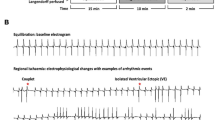Abstract
Each year in the United States alone some 250,000 persons die within one hour of an acute myocardial infarction. These deaths are largely due to ischemia-induced ventricular arrhythmias, primarily ventricular fibrillation (VF). Thus a safe, simple means of preventing such arrhythmias has considerable public health benefit potential. We have demonstrated that the intravenous infusion of n-3 polyunsaturated fatty acids (PUFA) from fish oils will prevent ischemia-induced VF in prepared, nonanesthetized, exercising dogs, confirming earlier feeding studies in rats. We show that this protective effect is due to an action of the free acidic form of the PUFA to alter the electrophysiology of individual cardiac myocyte so that the cells are electrically more stable. The electrophysiologic effects, in turn, result from direct and specific effects of the PUFA to block the fast voltage-dependent sodium channels. The binding of the free fatty acids is directly to the protein of the sodium channels and results in prolongation of the inactivated state of these channels. Other ion channels are also affected by the PUFA. Two clinical trials with n-3 PUFA are mentioned which inadvertently support the antiarrhythmic potential of PUFA ingestion.
Similar content being viewed by others
Abbreviations
- AA:
-
arachidonic acid
- BSA:
-
bovine serum albumin
- DHA:
-
docosahexaenoic acid
- EPA:
-
eicosapentaenoic acid
- PUFA:
-
polyunsaturated fatty acid
- VF:
-
ventricular fibrillation
References
Gulbjarnason, S., and Hallgrimson, J. (1975) The Role of Myocardial Membrane Lipids in the Development of Cardiac Necrosis,Acta. Med. Scand. suppl 587, 17–26.
Murnaghan, M.F. (1981) Effects of Fatty Acids on the Venticular Arrhythmia Threshold in the Isolated Heart of the Rabbit,Br. J. Pharmacol. 73, 909–915.
McLennan, P.L., Abeywardena, M.Y., and Charnock, J.S. (1985) Influence of Dietary Lipids on Arrhythimas and Infarction After Coronary Artery Ligation in Rats,Can. J. Physiol. Pharmacol. Pharmacol. 63, 1411–1417.
McLennan, P.L., Abeywardena, M.Y., and Charnock, J.S. (1988) Dietary Fish Oil Prevents Ventricular Fibrilation Following Coronary Artery Occlusion and Reperfusion,Am. Heart. J. 16, 709–717.
McLennan, P.L. (1993) Relative Effects of Dietary Saturated, Monounsaturated and Polyunsaturated Fatty Acids on Cardiac Arrhythmias in Rats,Am. J. Clin. Nutr. 57, 207–212.
Billman, G.E., Hallaq, H., and Leaf, A. (1994) Prevention of Ischemia-Induced Ventricular Fibrillation by n-3 Fatty Acids,Proc. Natl. Acad. Sci. USA 91, 4427–4430.
Kang, J.X., and Leaf, A. (1994) Effects of Long-chain Polyunsaturated Fatty Acids on the Contraction of Neonatal Rat Cardiac Myocytes,Proc. Natl. Acad. Sci. USA 91, 9886–9890.
Kang, J.X., and Leaf, A. (1995) Prevention and Termination of β-adrenergic Agonist-induced Arrhythmias by Free Polyunsaturated Fatty Acids in Noenatal Rat Cardiac Myocytes,Biochem. Biophys. Res. Com. 208, 629–636.
Kang, J.X., and Leaf, A. (1996) Protective Effects of Free Polyunsaturated Fatty Acids on Arrhythmias Induced by Lysophosphatidylcholine or Palmitylcarnitine in Neonatal Rat Myocytes,Euro. J. Pharmacol. 292, in press.
Tobias, L.T., and Hamilton, J.G. (1978) The Effect of 5,8,11,14-eicosatetraenoic Acid on Lipid Metabolism,Lipids 14, 181–193.
Kang, J.X., Xiao, Y.F., and Leaf, A. (1995) Free Long-chain Polyunsaturated Fatty Acids Reduce Membrane Electrical Excitability in Neonatal Rat Cardiac Myocytes,Proc. Natl. Acad. Sci. USA 92, 3997–4001.
Xiao, Y.F., Kang, J.X., Morgan, J.P., and Leaf, A. (1995) Blocking Effects of Polyunsaturated Fatty Acids on Na+ Channels of Neonatal Rat Ventricular Myocytes,Proc. Natl. Acad. Sci. 92, 11000–11004.
Burr, M., Gilbert, J.F., Holliday, R.M., Elwood, P.C., Fehily, A.M., Rogers, S., Sweetnum, P.M., and Deadman, N.M. (1989) Effects of Changes in Fat, Fish and Fibre Intakes on Death and Myocardial Reinfarction: Diet and Reinfarction Trial (DART),Lancet ii, 757–761.
de Logneril, M., Renaud, S., Mamelle, N., Salen, P., Monjaud, I., Guidollet, J., Touboul, P., and Delaye, J. (1994) Mediterranean α-linolenic Acid-rich Diet in Secondary Prevention of Coronary Heart Disease,Lancet 143, 1454–1459.
Lipid Research Clinics Program (1984) The Lipid Research Clinics Coronary Primary Prevention Trial Results: I. Reduction in Incidence of Cononary Heart Disease,JAMA 252, 351–364.
Hock, C.E., Beck, L.D., Bodine, R.C., and Reibel, D.K. (1990) Influence of Dietary n-3 Fatty Acids on Myocardial Ischemia and Reperfusion.Am. J. Physiol. 259 (Heart, Circ. Physiol. 28), H1518-H1526.
Author information
Authors and Affiliations
About this article
Cite this article
Kang, J.X., Leaf, A. The cardiac antiarrhythmic effects of polyunsaturated fatty acid. Lipids 31, S41–S44 (1996). https://doi.org/10.1007/BF02637049
Issue Date:
DOI: https://doi.org/10.1007/BF02637049




